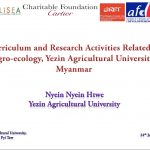
13 downloads
Title of document: Curriculum and Research activities related to Agro-ecology Yezin Agriculture University, Myanmar Authors: Nyein Nyein Htwe Journal’s name if any: Ministry/Government Agency/Organisation: ALiSEA, Charitable Foundation, GRET, AFD, Yezin Agriculture University Year of publication: 2017 Geographic focus: Myanmar Main issues / topics addressed (for example: LOCATION; Our vision and mission; Curriculum related to Agro-ecology; Research activities related to Agro-ecology……) School of agroecology (if any): Web address to original document (if any): Summary: This presentation for a brief overview Curriculum and Research activities related to Agro-ecology Yezin Agriculture University, Myanmar, at Regional academic conference addressing agroecology transition in the Mekong region, 24th & 25th January 2017, Yezin Agriculture University, Myanmar Read More

15 downloads
Title of document: Maejo University “Go-Eco” Strategy (Panel 4: Agroecology at university level, examples of current curriculum/actions) Authors: Assist. Prof. Dr. Surat Nuglor Journal’s name if any: Ministry/Government Agency/Organisation: MaeJo University, ALiSEA Year of publication: 2017 Geographic focus: Mekong Region Main issues / topics addressed (for example: General information of Maejo University; MJU Strategic roadmap; Some of MJU’s Innovations and Organic Agricultural Activities……) School of agroecology (if any): Web address to original document (if any): Summary: This presentation for a brief overview Maejo University, at Regional academic conference addressing agroecology transition in the Mekong region, 24th & 25th January 2017, Yezin Agriculture University, Myanmar Read More
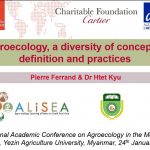
24 downloads
Title of document: Agroecology, a diversity of concepts, definition and practices Authors: Pierre Ferrand & Dr Htet Kyu Journal’s name if any: Ministry/Government Agency/Organisation: GRET, AFD, ALiSEA, Charitable Foundation Year of publication: 2017 Geographic focus: Mekong Region Main issues / topics addressed (for example: Why promoting ‘agroecology’ today?; Agroecology, a polysemic concept; Agroecology, a set of principles; Agroecology practices in Mekong Region……) School of agroecology (if any): Web address to original document (if any): Summary: This presentation for Regional Academic Conference on Agroecology in the Mekong Region, Yezin Agriculture University, Myanmar, 24th January 2017 Read More
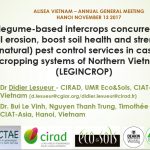
10 downloads
Title of document: Do legume-based intercrops concurrently halt soil erosion, boost soil health and strengthen (natural) pest control services in cassava cropping systems of Northern Vietnam? (LEGINCROP) Authors: Dr Didier Lesueur, Dr.Bui Le Vinh, Nguyen Thanh Trung, Timothée Herviault Journal’s name if any: Ministry/Government Agency/Organisation: ACTAE, CIRAD, UMR Eco&Sols, NOMASFI, DEAKIN Worldly, CIAT-Asia Year of publication: 2017 Geographic focus: Vietnam Main issues / topics addressed (for example: Overall and Specific Objectives; Preliminary results obtained in 2017; What is the way forward for 2018?……) School of agroecology (if any): Web address to original document (if any): Summary: This presentation for ALISEA Vietnam Annual General Meeting Hanoi - 13th of November 2017 Read More
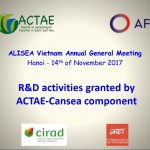
5 downloads
Title of document: R&D activities granted by ACTAE-Cansea component Authors: Journal’s name if any: Ministry/Government Agency/Organisation: ACTAE, AFD, CIRAD, GRET Year of publication: 2017 Geographic focus: Mekong Region Main issues / topics addressed (for example: About ACTAE; Objectives of CANSEA activities……) School of agroecology (if any): Web address to original document (if any): Summary: This presentation for a brief overview R&D activities granted by ACTAE-Cansea component, at ALISEA Vietnam Annual General Meeting Hanoi - 14th of November 2017 Read More
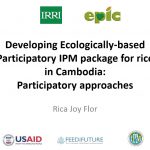
25 downloads
Title of document: Developing Ecologically-based Participatory IPM package for rice in Cambodia: Participatory approaches Authors: Rica Joy Flor Journal’s name if any: Ministry/Government Agency/Organisation: IRRI, Epic, USAID, Feed The Future, IPM Year of publication: Geographic focus: Cambodia Main issues / topics addressed (for example: EPIC project; Project Focus; Adaptive Research; Learning Alliances……) School of agroecology (if any): Web address to original document (if any): Summary: This presentation for a brief overview Developing Ecologically-based Participatory IPM package for rice in Cambodia: Participatory approaches Read More
8 downloads
Title of document: New Pathways: Farmer’s Ecological Innovations In Lam Dong Province Authors: Cao Thi Lan Journal’s name if any: Ministry/Government Agency/Organisation: Facultry of Agriculture and Forestry, DaLat University Year of publication: Geographic focus: Vietnam Main issues / topics addressed (for example: Pest outbreaks in Lam Dong, Pest control, Farmer’s innovations on pest control……) School of agroecology (if any): Web address to original document (if any): Summary: In Lam Dong Province: Cicadas on Coffee: Affect on 2.619 ha in year 2015 (over 40.000ha – in the whole high lands). they use chemicals pesticides but chemical overuses: High cost, low efficiency. And then, they Change to new varieties and technologies, after five years: Density of cicadas and mealybugs on coffee plant decreased Pesentation for New Pathways: Farmer’s Ecological Innovations In Lam Dong Province Read More
1 download
Title of document: Habitat eradication and cropland intensification may reduce parasitoid diversity and natural pest control services in annual crop fields Authors: Deborah K. Letourneau, Sara G. Bothwell Allen, Robert R. Kula, Michael J. Sharkey, John O. Stireman III Journal’s name if any: Elementa Ministry/Government Agency/Organisation: Department of Environmental Studies, University of California, Santa Cruz, California, United States ; Systematic Entomology Laboratory, Beltsville Agricultural Research Center, Agricultural Research Service, U.S. Department of Agriculture, c/o National Museum of Natural History, Smithsonian Institution, Washington, District of Columbia, United States ; Department of Entomology, University of Kentucky, Lexington, Kentucky, United States ; Department of Biological Sciences, Wright State University, Dayton, Ohio, United State Year of publication: 2015 Geographic focus: Global level Main issues / topics addressed (for example: Organic vegetable, parasitoid richnes, Insect sampling, identification, and host range determinations, Habitat elimination around farms and parasitoid diversity……) School of agroecology (if any): Web address to original document (if any): Summary: California’s central coast differs from many agricultural areas in the U.S., which feature large tracts of monoculture production fields and relatively simple landscapes. Known as the nation’s salad bowl, and producing up to 90% of U.S. production of lettuces, broccoli and Brussels sprouts, this region is a mosaic of fresh vegetable fields, coastal meadow, chaparral shrubs, riparian and woodland habitat. We tested for relationships between the percent cover of crops, riparian and other natural landscape vegetation and the species richness of parasitic wasps and flies foraging in crops, such as broccoli, kale and cauliflower, and interpreted our results with respect to the decrease in natural habitat and increase in cropland cover prompted by a local microbial contamination event in 2006. Our key results are that: (1) as cropland cover in the landscape increased, fewer species of parasitoids were captured in the crop field, (2) parasitoid richness overall was positively associated with the amount of riparian and other natural vegetation in the surrounding 500m, (3) different groups of parasitoids were associated with unique types of natural vegetation, and (4) parasitism rates of sentinel cabbage aphid and cabbage looper pests were correlated with landscape vegetation features according to which parasitoids caused the mortality. Although individual species of parasitoids may thrive in landscapes that are predominantly short season crops, the robust associations found in this study across specialist and generalist parasitoids and different taxa (tachinid flies, ichneumon wasps, braconid wasps) shows that recent food safety practices targeting removal of natural vegetation around vegetable fields in an attempt to eliminate wildlife may harm natural enemy communities and reduce ecosystem services. We argue that enhancing biological diversity is a key goal for transforming agroecosystems for future productivity, sustainability and public health. Read More
10 downloads
Title of document: Assessment of Rice IPM Practice and Inputs Authors: Roy Bateman and Le Cao Luong Journal’s name if any: Ministry/Government Agency/Organisation: Farmers and Storekeepers in Dong Thap – A Province in the Mekong Delta Region of Viet Nam. Year of publication: 2015 Geographic focus: National level Main issues / topics addressed (for example: Action thresholds, Natural enemies and biological control agent, IPM strategy, crop protection product, spraying practice and application equipment…) School of agroecology (if any): Web address to original document (if any): Summary: 1. A greatly improved training infrastructure is needed on pesticide science as part of the integrated pest management (IPM) curriculum: for farmers, spray contractors, retailers and agricultural colleges. Key weaknesses include the apparent confusion, by both store-keepers and farmers, about mode of action (MoA) with mode of dose transfer: in which case the prospects for effective IRM are fairly bleak. Products with questionable AI mixtures are a registration issue that should be addressed. Farmer ‘cocktails’ and late-season applications are also a significant problem. A curriculum for responsible selection and use of crop protection products is given, covering important health-related and technical issues such as: MoA, resistance, resurgence, residues (the ‘three Rs’), the importance of pre-harvest intervals and rational application techniques. 2. Pesticide application: existing practices are unsafe and inefficient. Most (>99 %) farmers and contractors walk into their own spray, with virtually all farmers relying on PPE as their ‘first line of defence’. The design of spraying equipment contributes to very inefficient application. Engineering solutions might involve the introduction of tail-booms and specifying equipment capable of using international nozzles, which would both improve safety and save famers money: both for labour (work rate) and more efficient use of PPPs. Volume application rates in post-tillering rice average 400 L/ha, but it is technically feasible to reduce this substantially, with commensurate reduction of inputs: thus potentially making the work attractive to farmers and attainable within a medium-term project. In the longer term, adoption of international (e.g. FAO, ISO) standards and higher-level training and research are needed in this area. We suggest the formation a national (or regional) pesticide application unit, possibly in the form of a University-based lab, be set-up to address these issues. 3. Only a small minority of farmers in Đồng Tháp even claim province practice IPM (84% reported that they do not) and most farmers evidently are spraying unnecessarily. Most farmers spray their fields merely on incidence of pests, or preventatively. An especially common insect thus treated is the rice leaf-roller, Cnaphalocrocis medinalis, with a large number of products specifically registered for this ‘pest’. Similar levels of BPH were reported by farmers (92% in Winter-Spring, 84% in Summer-Autumn crop); rice blast is the principal disease and Echinochloa spp. are the most important weeds. We suggest that it time to seriously re-evaluate the role of action thresholds as part of a realistic IPM strategy for the main rice pests and introduce clear, simple guide-lines for farmers: agreed by major stake-holders and conforming to a code of practice. Maintaining awareness of natural enemies is needed – especially for younger farmers in the post-1990s IPM-FFS generation, who are influenced by intensive advertising on the TV and elsewhere. However, a substantial minority (46%) are aware of natural enemies (NE) in their fields and a few farmers know about a wide range of NE. More than 80% of farmers claimed to use ‘selective pesticides’ (the question refers to all categories). However, biopesticides (if fermentation products are excluded) enjoy on a tiny proportion of the market: slow action and storage issues were frequently alluded-to as constraints, but as above, we discuss the need for realistic guide-lines for use and better training. Read More
4 downloads
Title of document: The Role of Pesticides in SE Asian Rice IPN; A view from the Mekong Delta Authors: Roy Bateman, ForestFloorLodge, Cát Tiên National Park, Viê.t Nam Journal’s name if any: Ministry/Government Agency/Organisation:. Cuu Long Delta Rice Research Institute, CropLife International, GIZ, Nong Lam University and the Plant Protection Department Year of publication: 2016 Geographic focus: ASIA Main issues / topics addressed (for example: Rice, Integrated Pest Management, responsible pesticide use, efficient spray application, action threshold, brown planthopper, blast disease, farmer and retail training …) School of agroecology (if any): Web address to original document (if any): Summary: Pesticide application remains an important component of rice pest management in Việt Nam and responsible use should be integrated back into a strategy of good agricultural practices. Crucial skills that need to be fostered include: better product selection with safe and efficient application; the role of action thresholds must also be re-considered. With such an important crop, strategies for good management perhaps inevitably become rather political in nature, with perverse consequences at the technical level. In many rice growing countries (besides VN) it is possible to identify where improvements may be made to pest management practices. There are a number of common issues, that sometimes become conflated and adopting an ‘anti-pesticide’ stance is not helpful: much better, surely, to adopt a set of rules where pesticides are truly used judiciously and as a last resort, on the understanding that a preventative approach is the basis of IPM. Over the coming years we intend to put this into practice. Read More

 Asia & Mekong Region
Asia & Mekong Region  Cambodia
Cambodia  Laos
Laos  Myanmar
Myanmar  Other
Other  Vietnam
Vietnam